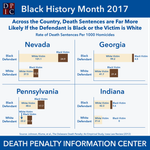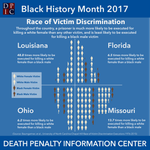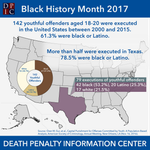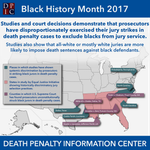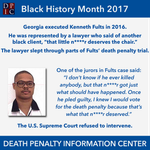During February DPIC posts infographics on race and the death penalty on our Facebook and Twitter pages.
View our 2019 Black History Month infographics collection here.
View our 2018 Black History Month infographics collection here.
View our 2017 Black History Month infographics collection below:
2017 Black History Month Infographic Series
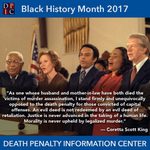
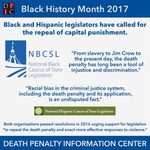
Saying that “racial bias In the criminal justice system, including the death penalty and its application, is an undisputed fact,” the National Hispanic Caucus of State Legislators in August 2016 adopted a resolution supporting repeal of the death penalty.
The National Black Caucus of State Legislators followed suit in December 2016, adopting its own resolution urging repeal of capital punishment. In it, the NBCSL wrote: “From slavery to Jim Crow to the present day, the death penalty has long been a tool of injustice and discrimination.”
On August 1, 2016, The Movement for Black Lives policy platform called for “an end to capital punishment,” which it described as “morally repugnant.” Asserting that “[t]he death penalty devalues Black lives,” the platform linked capital punishment with the history of race-based lynchings in the United States.

Anthony Ray Hinton was exonerated in April 2015 after spending nearly 30 years on Alabama’s death row. He was wrongly convicted of the 1985 murders of two fast-food restaurant managers based upon the false testimony of a state forensic examiner that the bullets in the two murders came from a gun found in Hinton’s house.
The prosecutor — who had a documented history of racial bias — had said he could tell Mr. Hinton was guilty and “evil” just by looking at him. Mr. Hinton was arrested after a victim in a similar crime identified him in a photo lineup, even though he had been working in a locked warehouse 15 miles away when that crime was committed and could not possibly have committed it.
Ray Hinton told the CBS News show 60 Minutes of a chilling conversation he had with a police lieutenant at the time of his arrest: “ ‘You got a white man. They gonna say you shot him. Gonna have a white D.A. We gonna have a white judge. You gonna have a white jury more than likely.’ And he said, ‘All of that spell conviction, conviction, conviction.’ I said, ‘Well, does it matter that I didn’t do it?’ He said, ‘Not to me.’ ”
Mr. Hinton’s lawyer was ignorant of the law and incorrectly believed that funding to hire a qualified firearms expert was not available. Rather than seeking necessary funding, he instead hired an expert he knew to be inadequate. As a result, he failed to present any credible evidence to rebut the state’s claim that the bullets had been fired from Mr. Hinton’s gun.
In 2002, three top firearms examiners testified that the bullets could not be matched to that gun, and may not have come from a single gun at all. In 2014, the U.S. Supreme Court unanimously held that Mr. Hinton’s lawyer had provided substandard representation and returned the case to the state courts for further proceedings. Prosecutors decided not to retry him after the state’s new experts said they could not link the bullets to Mr. Hinton’s gun.
Bryan Stevenson, Mr. Hinton’s lead attorney, said, “Race, poverty, inadequate legal assistance, and prosecutorial indifference to innocence conspired to create a textbook example of injustice. I can’t think of a case that more urgently dramatizes the need for reform than what has happened to Anthony Ray Hinton.”
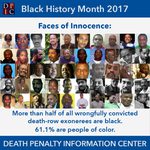
Between 1973 and February 6, 2017, 157 men and women who were wrongly convicted and sentenced to death have been exonerated.
82 of these wrongfully convicted death-row exonerees (52.2%) are black. 12 (7.6%) are Latino. One each are Thai or Jordanian.
Taken together, 61.1% of U.S. death-row exonerees are people of color.
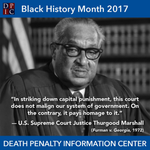
Civil rights lawyer and founder of the NAACP Legal Defense & Educational Fund Thurgood Marshall became the first African American to serve as a Justice of the United States Supreme Court. Justice Marshall believed that the death penalty constituted cruel and unusual punishment in violation of the Eighth Amendment because of its arbitrary and discriminatory application.
In his opinion concurring in the Court’s 1972 decision in Furman v. Georgia to declare existing death penalty statutes unconstitutional, Justice Marshall wrote: “Assuming knowledge of all the facts presently available regarding capital punishment, the average citizen would, in my opinion, find it shocking to his conscience and sense of justice. For this reason alone, capital punishment cannot stand.”
Marshall viewed the independence of the Courts as a vital component of American democracy. “In striking down capital punishment,” he wrote. “this court does not malign our system of government. On the contrary, it pays homage to it.”
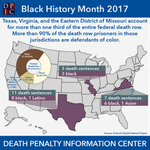
The racial and geographic arbitrariness of the federal death penalty is illustrated by the gross overrepresentation of prisoners of color in a small number of jurisdictions that account for a disproportionate number of federal death sentences nationwide.
By themselves, Texas, Virginia, and the Eastern District of Missouri account for more than a third of all of the prisoners on federal death row (21 of 62). But these jurisdictions do more than simply overproduce death sentences. They do so in a grossly discriminatory manner. More than 90% of those condemned in these federal jurisdictions are prisoners of color.
Federal district courts in Texas have condemned 11 federal defendants to death. 9 of them (8 black, 1 Latino), or 82%, are prisoners of color. All 7 defendants condemned to die in Virginia’s federal courts are prisoners of color (6 black, 1 Asian). And in the Eastern District of Missouri, which encompasses suburban St. Louis communities such as Ferguson, all three condemned federal prisoners are black.
These jurisdictions contribute greatly to the overall racial disproportionality of the U.S. federal death row. As of February 7, 2016, 62 prisoners were on the U.S. federal death row. 60% were defendants of color. 44% of the condemned prisoners are black (27), the largest concentration of any racial or ethnic group. Another 11% (7 prisoners) are Latino and a combined 3% are Asian or Native American (1 each). 42% of the federal death-row prisoners are white (26).
Source: Federal Capital Habeas Project
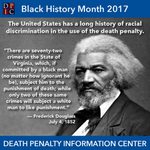
Suggestions that the death penalty in the United States is disproportionately applied on the basis of race are nothing new. The United States has a long history of racial discrimination in the use of the death penalty, and for much of our history death penalty laws were overtly discriminatory.
As Frederick Douglass, one of the most prominent African American advocates of the abolition of slavery observed on the occasion of America’s celebration of Independence Day in 1852: “There are seventy-two crimes in the state of Virginia which, if committed by a black man (no matter how ignorant he be), subject him to the punishment of death; while only two of these same crimes will subject a white man to like punishment.”
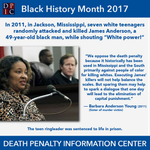
On June 26, 2011, seven white teenagers randomly targeted and attacked James Anderson on the streets of Jackson, Mississippi. They chose Anderson simply because he was black. While shouting “White power,” the teens took turns beating Anderson, and then one of them killed him by driving over him with a truck.
White supremacist hate murders pose particularly difficult questions for those concerned about racial discrimination in the use of the death penalty and the death penalty’s historical relationship to slavery and lynching. These types of murders are widely regarded as among the most morally reprehensible, but critics say the use of capital punishment in these cases may have the effect of legitimizing a system that has long been discriminatorily applied against defendants of color.
Mr. Anderson’s family asked the Jackson District Attorney not to seek the death penalty for his killer. Mr. Anderson’s sister, Barbara Anderson Young, wrote a letter to the D.A. on behalf of their mother and two brothers, saying that opposition to the death penalty was “deeply rooted in our religious faith, a faith that was central in James’ life as well.” The letter continued, “We also oppose the death penalty because it historically has been used in Mississippi and the South primarily against people of color for killing whites. Executing James’ killers will not help balance the scales. But sparing them may help to spark a dialogue that one day will lead to the elimination of capital punishment.” Though old enough to face the death penalty, the teenaged ringleader of the murder was sentenced to life in prison.
On September 21, 2011, Texas executed Lawrence Brewer, a white supremacist who chained James Byrd, Jr., an African-American man, to a truck and dragged him to death in Jasper in 1998. Some members of Mr. Byrd’s family also opposed the death penalty. Mr. Byrd’s murder helped spur the adoption of federal hate crimes legislation. Although proponents of the Matthew Shepard/James Byrd Jr. Federal Hate Crimes Act intentionally excluded the use of the death penalty as a punishment for hate crimes, federal prosecutors used it as a basis to seek the death penalty against Dylann Roof for the racially motivated murders of nine black parishioners at an historic African-American church in Charleston, South Carolina. The NAACP Legal Defense & Educational Fund opposed the death penalty in Roof’s case saying it “would have the perverse effect of justifying the routine, racially discriminatory imposition of the death penalty on black people.” A poll by the University of South Carolina’s Institute for Public Service and Policy Research found that only 30.9% of black South Carolinians favored the death penalty for Roof, while 64.7% believed he should be sentenced to life without parole.
(See Christina Swarns, Director of Litigation, NAACP Legal Defense & Educational Fund, Op-Ed: Dylann Roof Shouldn’t Get the Death Penalty, The New York Times, Nov. 7, 2016; Monique L. Lyle & Robert W. Oldendick, One Year Later: Race Relations and the Emanuel 9 Shooting, Institute for Public Service and Policy Research, University of South Carolina, June 2016; DPIC, NEW VOICES: In Inter-racial Killing, Victim’s Family Asks District Attorney Not to Pursue Death Penalty, September 22, 2011.)
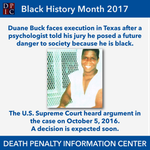
Duane Buck was sentenced to death in Harris County (Houston), Texas in 1997 after his own lawyers presented an expert witness who testified that Mr. Buck was more likely to pose a future danger to society because he is black.
Juries in Texas may not impose the death penalty unless they find that a defendant poses a continuing threat to society. The prosecutor at Buck’s sentencing trial asked psychologist Walter Quijano, without any objection by the defense: “The race factor, black, increases the future dangerousness for various complicated reasons; is that correct?” “Yes,” Quijano said. The prosecutor stressed this testimony in his closing argument, again without objection by the defense.
Buck was one of seven cases in which Quijano told juries that defendants were more likely to commit future crimes if they were black or Hispanic. In 2000, then-Texas Attorney General John Cornyn (now a U.S. Senator) agreed that the seven cases had been tainted by improper testimony. “It is inappropriate to allow race to be considered as a factor in our criminal justice system,” Cornyn said. “The people of Texas want and deserve a system that affords the same fairness to everyone.” The other six death-row prisoners received new sentencing trials; only Duane Buck did not.
The Texas state and federal courts have repeatedly denied relief to Mr. Buck on this issue. The United States Supreme Court agreed to review his case and heard argument on October 5, 2016. A decision is expected soon.
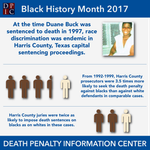
Racially discriminatory sentencing in capital cases was nothing new in Harris County, Texas, when Duane Buck’s jury sentenced him to death in 1997. Instead, statistical evidence suggests that race discrimination was endemic in capital sentencing proceedings in the county at that time.
A study by University of Maryland Professor Raymond Paternoster found that from 1992 – 1999, in cases similar to Buck’s, the Harris County District Attorney’s Office sought the death penalty 3.5 times more often when the defendant was black than when the defendant was white. Professor Paternoster found that Harris County juries were twice as likely to impose death sentences on blacks in these cases as compared to white defendants.
A 2012 study by University of Denver Professor Scott Phillips found significant racial and gender disparities in Harris County’s application of the death penalty during the years 2001 to 2008. Prof. Phillips found that death sentences were imposed in cases involving white victims at 2.5 times the rate one would expect in a race-neutral system. The study found that when the victim was both white and female, death sentences were imposed at 5 times the rate than if the system were blind to race and gender.
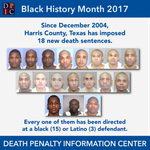
More prisoners sentenced to death in Harris County have been executed than from any other county in the United States. However, Harris has experienced a decline in new death sentences in recent years that parallels the nationwide decline in capital sentencing. Although the 10 new death sentences imposed in Harris County from 2010 – 2015 are more than were imposed in 99.5% of U.S. counties, they are significantly fewer than the 53 new death sentences that were handed down in Harris in 1998 – 2003 and the 16 from 2004 – 2009. No new death sentences were imposed in the county in 2016.
But at the same time that death sentences have decreased, the overall composition of the county’s death row has become even more racially disproportionate. Since December 2004, Harris County has imposed 18 new death sentences (this excludes resentencing proceedings involving prisoners already on death row). Every one of those sentences has been directed at a defendant who is either black (15) or Latino (3).
Those death sentences included the wrongful conviction of Alfred Dwayne Brown, who was exonerated in June of 2015, and the wrongful imposition of the death penalty upon Roosevelt Smith, Jr., who was later found to be ineligible for the death penalty as a result of intellectual disability.
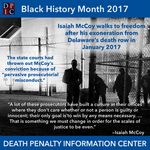
Isaiah McCoy walks to freedom after his exoneration from Delaware’s death row in January 2017.
Mr. McCoy is the 157th person exonerated from death row in the United States, and the 82nd African American. He is Delaware’s first death-row exoneration, although there is substantial evidence that former death-row prisoner Jermaine Wright, who was released in 2016 after pleading no-contest to lesser charges in his retrial, is also innocent.
Mr. McCoy was convicted and sentenced to death in 2012 for two drug-related murders. No physical evidence linked him to the murders, and he was convicted based upon the contradictory testimony of two alleged accomplishes who were themselves involved in the murder. At the time of trial, Delaware was one of three states that permitted judges to impose death after a non-unanimous sentencing recommendation by the jury (the others were Florida and Alabama). His jury voted 10 – 2 to recommend death, and the trial judge imposed that sentence. Data suggests that these non-unanimity statutes may increase the risk of wrongful death sentences. 24 of the 26 death-row exonerations in which the jury vote is known in these three states (92.3%) were cases in which jurors had reached non-unanimous recommendations for death or judges had overridden jury recommendations of life.
Mr. McCoy decided to represent himself at trial when his lawyer — who had not investigated the case — informed him just before trial started that he was going to tell the jury that McCoy had been present at the murder but had not committed the kiling. The prosecutor, Deputy Attorney General R. David Favata, chose to take advantage of McCoy’s decision to represent himself by engaging in what the Delaware Supreme Court described as “pervasive unprofessional conduct … that permeated these proceedings and compromised McCoy’s right of self-representation.” The Court later suspended Favata from the practice of law for his misconduct. Among other things, Favata belittled McCoy for choosing to represent himself; threatened to tell prison authorities (falsely) that McCoy was a snitch; made intimidating comments directed at McCoy during a break in proceedings, then lied to the judge about having made the comments; prevented stand-by counsel from giving McCoy advice unless McCoy first specifically requested it; and improperly vouched for the credibility of a key prosecution witness.
The Delaware Supreme Court overturned Mr. McCoy’s conviction in 2015. McCoy waived his right to a jury for his retrial, and in a January 2017 bench trial in front of Kent County Superior Court Judge Robert B. Young was acquitted of all charges. Upon his release, McCoy said, “I just want to say to all those out there going through the same thing I’m going through ‘keep faith, keep fighting. Two years ago, I was on death row. At 25, I was given a death sentence – and I am today alive and well and kicking and a free man.” During a podcast interview with DPIC, he said: “A lot of these prosecutors have built a culture at their offices where they don’t care whether or not a person is guilty or innocent; their only goal is to win by any means necessary. … That is something we must change in order for the scales of justice to be even.”
Mr. McCoy was the second former death-row prisoner in a year to be released in Delaware after obtaining a new trial for prosecutorial misconduct. In May 2014, Jermaine Wright won a new trial after 21 years on death row when prosecutors and police withheld exculpatory evidence about possible alternate suspects in a case in which no forensic or eyewitness evidence had linked Mr. Wright to the crime. He was released in September 2016 after pleading no contest to lesser charges and being resentenced to time already served. Mr. Wright had previously overturned his death sentence, but had been resentenced to death. On both occasions, as in Mr. McCoy’s case, the judge imposed a death sentence even though the sentencing jury’s sentencing recommendation had not been unanimous.

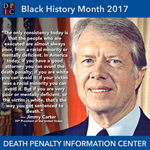
After the United States Supreme Court declared existing death penalty statutes unconstitutional in Furman v. Georgia in 1972, the Georgia legislature acted swiftly to authorize a new statute that authorized the death penalty for murder, rape, and robbery. Governor Jimmy Carter signed the death penalty bill into law in 1973.
By the time he ran for President in 1976, Carter had changed his mind about the death penalty and has consistently opposed it since. In a November 2013 interview with The Guardian, former President Carter said it is “almost inconceivable … to imagine that a rich white man would be executed [in the United States] if he murdered a black person.” Carter said:
“The only consistency today is that the people who are executed are almost always poor, from a racial minority or mentally deficient. In America today, if you have a good attorney you can avoid the death penalty; if you are white you can avoid it; if your victim was a racial minority you can avoid it. But if you are very poor or mentally deficient, or the victim is white, that’s the way you get sentenced to death.”
